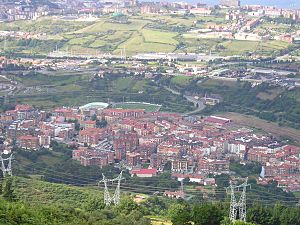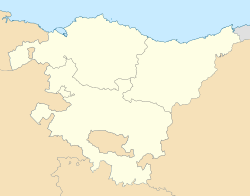Valle de Trápaga-Trapagaran facts for kids
Quick facts for kids
Valle de Trápaga-Trapagaran
Trapagaran
Valle de Trápaga |
|||
|---|---|---|---|
 |
|||
|
|||
| Country | Spain | ||
| Autonomous community | Basque Country | ||
| Province | Biscay | ||
| Eskualdea | Greater Bilbao | ||
| Founded | 1841 | ||
| Area | |||
| • Total | 13.1 km2 (5.1 sq mi) | ||
| Elevation | 35 m (115 ft) | ||
| Population
(2018)
|
|||
| • Total | 11,953 | ||
| • Density | 912/km2 (2,363/sq mi) | ||
| Time zone | UTC+1 (CET) | ||
| • Summer (DST) | UTC+2 (CEST) | ||
| Postal code |
48510
|
||
Valle de Trápaga-Trapagaran is a town and municipality in northern Spain. It is part of the Basque Country region, in the province of Biscay. The town is close to other places like Barakaldo and Portugalete.
People have dug for iron here since ancient Roman times. The town has two main parts, one higher up and one lower down. A special train called a funicular railway connects these two areas. In 2019, about 11,985 people lived in Valle de Trápaga-Trapagaran.
Contents
Exploring Valle de Trápaga-Trapagaran
Valle de Trápaga-Trapagaran is located about 12 kilometers (7.5 miles) from Bilbao. It sits within the Triano mountain range in the province of Biscay. The town is split into two different areas.
Lower Zone: The Main Area
Most of the people, about 90%, live in the lower part of the town. This area includes neighborhoods like Durañona, El Juncal, and Ugarte. The main administrative center, where the town hall is, is also in this lower zone. A major road, the European route E70, passes by the town along the northern coast of Spain.
Upper Zone: Mountain Views
The upper part of the town is in the Triano mountains. Here you'll find neighborhoods such as La Arboleda and La Reineta. This higher zone is connected to the lower part by a road (BI-3755) and a unique funicular railway.
The Funicular Railway
The funicular railway is very special. It's the only one in Spain that has horizontal cabins. This means you can enjoy amazing panoramic views of the Estuary of Bilbao as you travel. It's a great way to see the area!
Town's Architecture and History
Valle de Trápaga-Trapagaran grew a lot because of the mining activities. Many of its buildings were built in the late 1800s and early 1900s.
Important Buildings
- The Church of San José Obrero is built in a Romanesque style.
- The Church of San Juan Bautista has a neoclassical design.
- The city hall, built in the early 1900s, also shows neoclassical style.
Mining Past and Present Parks
Iron ore has been mined in this area since Roman times. Mining really increased in the upper zone after a railway was built in the late 1800s. This led to more people moving there.
From Mines to Recreation
By the mid-1900s, the iron ore was mostly gone. Now, the area is mainly residential and used for fun activities. You can still see signs of its industrial past. Many old mines have filled with water and become lakes. These areas are now used for sports and fishing, offering great places for people to relax and play.
See also
 In Spanish: Valle de Trápaga para niños
In Spanish: Valle de Trápaga para niños




